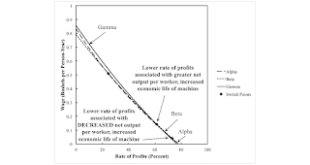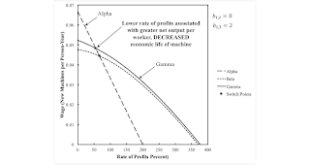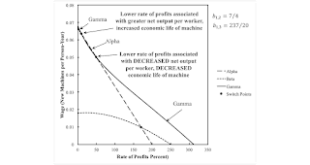1.0 Introduction I have explained this before. Suppose one insists socialism requires central planning. In his 1920 paper, 'Economic calculation in the socialist commonwealth', Ludwig Von Mises claims that a central planner requires prices for capital goods and unproduced resources to successfully plan an economy. The claim that central planning is impossible without market prices is supposed to be a matter of scientific principle. Von Mises was mistaken. His error can be demonstrated to...
Read More »Hayek In The Pure Theory Of Capital
This is more of my commonplace book, based on reading some of Hayek's The Pure Theory of Capital. Hayek rejects Böhm Bawerk's average period of production, a single number summarizing the capital intensity of a structure of production. He still strives to say that more capital-intensive techniques are longer in some non-aggregate sense. I probably will not finish this book. To compare and contrast this book with J. R. Hicks' Value and Capital would be of interest. Hayek correctly takes...
Read More »Marxian Political Economy As Forward-Looking
Every child knows a nation which ceased to work, I will not say for a year, but even for a few weeks, would perish. Every child knows, too, that the masses of products corresponding to the different needs required different and quantitatively determined masses of the total labor of society. That this necessity of the distribution of social labor in definite proportions cannot possibly be done away with by a particular form of social production but can only change the mode of its appearance...
Read More »Austrian School Claims About The Period Of Production And Capital
1.0 Introduction Economists of the Austrian school generally retain some concept that lower interest rates incentivize capitalists or entrepreneurs to adopt more lengthy production processes, in some sense, while still rejecting aggregate physical measures of roundaboutness or capital intensity. This post collects some quotations of economists of the Austrian school or Austrian-adjacent saying such or saying something confused about the Cambridge Capital Controversy. I want to recall this...
Read More »A Perverse Switch Point For Neoclassical Economics, Non-Perverse For Austrians
Figure 1: The Wage-Rate of Profits Frontier1.0 Introduction This post completes a demonstration that the economic life of a machine is independent of the capital-intensity of a technique. I here fill in the upper right of a two-by-two table. I have previously filled in the upper-left and lower right entries. And I also have an example for the lower left. 2.0 Technology Tables 1 and 2 present coefficients of production for processes which can be combined to produce a new output of corn....
Read More »Perverse Switch Point For Austrian Economics
Figure 1: The Wage-Rate of Profits Frontier This post continues a series of posts demonstrating that the change in the economic life of a machine at a switch point is independent of the change of the capital intensity of the technique at a switch point. I here fill in the lower left in a a two-by-two table. The wage curves above are for the an example with the same structure as in the previous post in this series.This is a 'one-good' model. The manager of firms know three processes to...
Read More »Traditional And ‘Perverse’ Switch Points For Austrian And Neoclassical Economics
Figure 1: The Wage-Rate of Profits Frontier1.0 Introduction This is one in a series of posts demonstrating that the change in the economic life of a machine at a switch point is independent of the change of the capital intensity of the technique at a switch point. I want to illustrate each entry in a two-by-two table in a previous post. The example in this post has two switch points. One fits the traditional Austrian and neoclassical stories, as in the entry in the upper-left of the table....
Read More »To Do: Perverse Switch Points And The Economic Life Of A Machine
Table 1: Lower Rate of Profits Around A Switch Point Traditional Marginalist Story'Perverse' Marginalist StoryTraditional Austrian StoryNegative real Wicksell effect, greater net output per workerPositive real Wicksell effect, smaller net output per workerLonger economic life of machineLonger economic life of machine'Perverse' Austrian StoryNegative real Wicksell effect, greater net output per workerPositive real Wicksell effect, smaller net output per workerShorter economic life of...
Read More »Austrian Economists Rediscovering Sraffa
Some recent papers by economists of the Austrian school rediscover some aspects of post-Sraffian price theory. Others would benefit from more knowledge of post-Sraffian price theory. But the authors do not know this. Fillieule (2007) is a rediscovery of Sraffa's standard commodity. He sets out a special case of Hayekian triangles in which an infinite series of datad labor inputs are used to produce current net output. "Only circulating capital is taken into account", and "the proportion...
Read More »Problems With The Economic Calculation Problem
[embedded content]Hakim on the Economic Calculation Problem Reactionaries often bring up the Economic Calculation Problem (ECP) as a fatal objection to socialism, considered as entailing central planning. Ludwig Von Mises put this forth in 1920 as an argument in principle that central planning is guaranteed to be highly inefficient. He postulates that the planning authority knows the prices of consumer goods and all technical possibilities, including the endowments of originary factors of...
Read More » Heterodox
Heterodox



